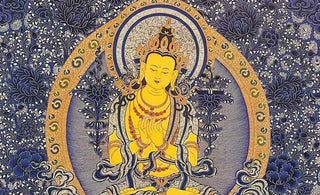
Introduction:
Thangka paintings, deeply entrenched in the rich tapestry of Tibetan Buddhist tradition, unfold as a captivating canvas that transcends the boundaries of conventional artistic expression. Originating from the sacred landscapes of the Himalayan region, these paintings offer a unique fusion of spirituality and artistry, creating a visual masterpiece that goes beyond mere aesthetics to captivate the very soul. Within this intricate art form lies the delicate and precise technique known as "line work," serving as the backbone that breathes life into the divine narratives depicted on the Thangka canvas.
I. The Spiritual Symphony of Thangka Art:
Thangka art, at its core, transcends the superficial allure of aesthetics. It serves as a conduit into the spiritual dimensions, where each brushstroke and color choice carries profound meaning. These paintings act as portals, not merely showcasing images but conveying the essence of deities, cosmic landscapes, and the interconnectedness of all things. Thangka art is a sacred endeavor that resonates as a spiritual symphony, drawing in those who seek a profound understanding of existence.
II. Line Work: The Architectural Essence of Thangka Painting:
At the heart of Thangka art lies the meticulous technique of line work. Far beyond a mere technicality, line work acts as the architectural essence, defining forms, instilling clarity, and contributing to the overall harmony of the composition. It is through the precision of line work that artists breathe life into the divine figures and intricate scenes, creating a visual language that speaks to the soul.
III. Symbolism Woven in Line Work:
Line work in Thangka paintings is laden with symbolism, adding layers of meaning to the visual narrative. Delicate lines may represent compassion, while bold strokes signify power and wisdom. The choice of lines is a conscious decision by the artist to infuse the artwork with spiritual significance, creating a tapestry of symbols that guide the viewer through the deeper realms of Tibetan Buddhism.
In Thangka paintings, the depiction of deities is a common theme, and each deity is characterized by specific attributes and symbolism. Consider the portrayal of Chenrezig, the Bodhisattva of Compassion, whose image is often graced with intricate line work that goes beyond the delineation of form.
The lines used to outline Chenrezig's thousand arms and multiple heads serve as a representation of his boundless compassion. Each arm, adorned with an eye on the palm, symbolizes his watchful presence and compassionate gaze upon all sentient beings. The delicate lines not only define the physical attributes of the deity but also convey the idea of interconnectedness and the omnipresence of compassion in the universe.
Furthermore, the choice of line quality contributes to the symbolism. Soft, flowing lines may represent the gentleness and warmth of compassion, while more pronounced and angular lines can signify the strength and transformative power of Chenrezig's compassion. The juxtaposition of these line variations creates a visual language that communicates the multifaceted nature of the Bodhisattva's virtues.
IV. Tools and Techniques of Line Work:
The execution of precise line work demands a mastery of tools and techniques. Fine brushes, crafted from natural fibers like sable or goat hair, provide the necessary delicacy for intricate detailing. Pigments, derived from minerals and natural sources, are mixed with binding mediums to achieve the desired consistency for controlled application. Thangka artists employ stippling, hatchings, and single brush stroke techniques to create textures, gradients, and continuous lines that define the contours of the sacred figures.
V. The Meditative Process of Line Work:
Creating precise line work in Thangka painting is a meditative process. Artists engage in preparatory practices such as controlled breathing and mindfulness, centering themselves before embarking on the intricate task of outlining. This meditative approach not only enhances concentration but also infuses the artwork with spiritual energy, aligning the artist's intentions with the sacred subject matter.
VI. Preservation and Restoration:
The delicate nature of Thangka line work requires careful preservation to ensure the longevity of these sacred artworks. Additionally, when restoration becomes necessary due to aging or damage, skilled conservators employ meticulous techniques to recreate the original line work, maintaining the integrity and beauty of these timeless creations.
Conclusion:
In the captivating canvas of Thangka art, line work emerges as a foundational element, weaving together the spiritual symphony of Tibetan Buddhist tradition with the artistic tapestry of the Himalayan region. The precision and symbolism inherent in Thangka line work serve not only as a visual feast for the eyes but also as a profound journey into the depths of spirituality and existence. Through the delicate strokes of the artist's brush, the essence of Thangka art continues to resonate, inviting viewers into a world where the divine is intricately entwined with the artistry of the sacred canvas.























